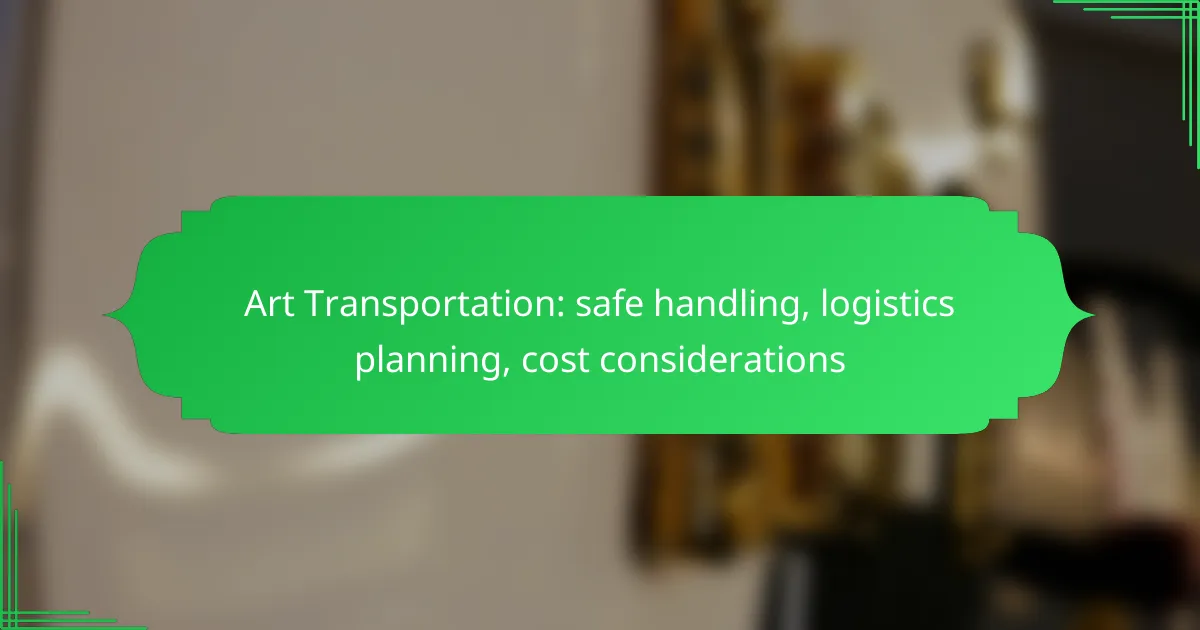Transporting art requires meticulous attention to safe handling, logistics planning, and cost considerations to ensure the integrity of the artwork. Utilizing appropriate packing materials, trained professionals, and climate control measures is essential for minimizing damage during transit. Effective logistics planning involves careful coordination and scheduling, while understanding the various cost factors helps in budgeting for a successful transportation process.

How to ensure safe handling of art during transportation?
To ensure safe handling of art during transportation, it is crucial to use appropriate packing materials, employ trained professionals, and implement climate control measures. Each of these steps minimizes the risk of damage and preserves the integrity of the artwork throughout the logistics process.
Use specialized packing materials
Specialized packing materials are essential for protecting art during transportation. Use acid-free tissue paper, bubble wrap, and sturdy cardboard boxes designed for art to prevent scratches and impacts. Avoid using regular packing tape; instead, opt for tape that won’t leave residue on the artwork.
Consider using corner protectors and foam padding for additional cushioning. These materials help absorb shocks and vibrations, which can occur during transit, especially over long distances.
Employ trained art handlers
Employing trained art handlers is vital for the safe transportation of artwork. These professionals understand the nuances of handling various types of art, including paintings, sculptures, and delicate installations. They are skilled in lifting techniques and know how to secure items properly for transport.
Hiring experienced handlers can significantly reduce the risk of accidents. Look for individuals or companies with a proven track record in art logistics and positive references from previous clients.
Implement climate control measures
Climate control measures are critical for preserving the condition of art during transportation. Fluctuations in temperature and humidity can cause damage to sensitive materials like canvas, wood, and paper. Use climate-controlled vehicles or containers to maintain stable conditions throughout the journey.
Monitoring devices can be installed to track temperature and humidity levels in real-time. This ensures that any deviations from the ideal range can be addressed immediately, protecting the artwork from potential harm.
Conduct pre-transport inspections
Conducting pre-transport inspections is essential to identify any existing damage and ensure that the artwork is ready for transport. Document the condition of each piece with photographs and written descriptions before packing. This record can be invaluable for insurance purposes and for addressing any disputes that may arise.
Check for loose frames, cracks, or other vulnerabilities that could worsen during transit. Addressing these issues beforehand can help prevent further damage and ensure a smoother transport process.
Utilize custom crates for fragile items
Utilizing custom crates for fragile items is a best practice in art transportation. Custom crates are designed to fit the specific dimensions and weight of the artwork, providing maximum protection. They often include additional padding and support to secure the piece in place.
While custom crates may involve higher upfront costs, they can save money in the long run by reducing the risk of damage. For high-value pieces, investing in a custom solution is often worth the expense to ensure safe handling during transportation.

What logistics planning is required for art transportation?
Effective logistics planning for art transportation involves careful consideration of transport methods, scheduling, and coordination with relevant institutions. Proper planning ensures the artwork’s safety and integrity throughout the journey.
Choose appropriate transport methods
Selecting the right transport method is crucial for protecting art pieces. Options include air freight for speed, ground transport for cost-effectiveness, and specialized art transport services that offer climate control and security. Consider the size, weight, and fragility of the artwork when making your choice.
For high-value items, using a dedicated art logistics company may be worth the investment. They provide tailored solutions that minimize risk and ensure compliance with international shipping regulations.
Schedule transport during off-peak hours
Transporting art during off-peak hours can significantly reduce the risk of delays and damage. Traffic congestion can lead to longer travel times, increasing the likelihood of mishaps. Aim for early mornings or late evenings when roads are less crowded.
Additionally, consider the timing of your transport in relation to weather conditions. Avoiding adverse weather can further safeguard the artwork during transit.
Coordinate with galleries and museums
Effective coordination with galleries and museums is essential for seamless art transportation. Communicate transport schedules and requirements well in advance to ensure that receiving institutions are prepared to handle the artwork upon arrival.
Establishing clear lines of communication can help address any potential issues, such as changes in exhibition dates or unexpected delays, ensuring a smooth transfer process.
Develop a detailed timeline
A detailed timeline outlines every step of the transportation process, from packing to delivery. Include milestones for packing, loading, transit, and unloading to keep all parties informed and accountable.
Regularly review and adjust the timeline as needed, especially if unexpected challenges arise. This proactive approach minimizes disruptions and helps maintain the integrity of the art during transport.
Assess route risks and alternatives
Evaluating potential route risks is a critical step in logistics planning. Identify areas prone to traffic issues, construction, or adverse weather conditions that could impact the transport of art.
Having alternative routes prepared can save time and reduce stress during transportation. Consider using mapping tools to analyze different paths and select the safest and most efficient option for your specific needs.

What are the cost considerations for art transportation?
Cost considerations for art transportation include various factors that can significantly impact the overall expense. Understanding these elements helps in budgeting effectively for safe and efficient art logistics.
Factor in insurance costs
Insurance is a critical aspect of art transportation, as it protects against potential loss or damage during transit. Depending on the value of the artwork, insurance costs can range from a few percent to over ten percent of the total value. Always verify that the insurance covers the full value and any specific risks associated with the artwork.
When selecting an insurance provider, consider their experience with art logistics and the types of coverage they offer. Some policies may include additional protections for high-value pieces or specific types of damage.
Calculate packing and crating expenses
Packing and crating are essential for ensuring the safety of artwork during transportation. Costs for custom crates can vary widely, typically ranging from low hundreds to thousands of USD, depending on the size and fragility of the piece. Using high-quality materials and professional packing services can prevent damage and reduce overall costs in the long run.
Consider the type of artwork you are transporting. For instance, fragile pieces may require specialized crating, which can increase expenses. Always get quotes from multiple providers to compare pricing and services.
Include labor costs for handling
Labor costs are another significant factor in art transportation. This includes the expenses associated with packing, loading, unloading, and installation. Depending on the complexity of the job, labor costs can range from hourly rates of around $20 to $100 or more per worker.
When planning for labor, consider the number of workers needed and the time required for each task. Hiring experienced professionals can ensure proper handling, which is crucial for valuable artworks.
Account for transportation distance
The distance of transportation directly affects costs, as longer distances typically incur higher fees. Shipping costs can vary based on the mode of transport—ground, air, or sea—with air transport generally being the most expensive option. For example, domestic shipping might cost a few hundred USD, while international shipping can escalate to thousands.
When planning transportation, evaluate the most cost-effective route and method. Sometimes, a longer route may offer lower shipping rates, so consider all options before making a decision.
Evaluate potential customs fees
Customs fees can significantly impact the cost of transporting art internationally. These fees vary by country and can include tariffs, taxes, and handling charges. It’s essential to research the specific regulations and costs associated with the destination country to avoid unexpected expenses.
To minimize customs fees, ensure that all paperwork is accurate and complete. Working with a customs broker familiar with art transportation can help navigate these complexities and potentially reduce costs.

What are the best practices for art transportation in the UK?
Best practices for art transportation in the UK involve careful planning, specialized handling, and cost-effective logistics. Ensuring the safety and integrity of artworks during transit is paramount, requiring attention to detail and adherence to industry standards.
Safe handling of artworks
Safe handling of artworks is critical to prevent damage. Use gloves when touching pieces to avoid oils and dirt from hands, and always support artworks from their bases or frames. Employ specialized packing materials, such as acid-free tissue, bubble wrap, and sturdy crates, to cushion items during transport.
When moving larger pieces, consider using professional art handlers who are trained in the nuances of art transportation. They understand how to navigate potential hazards and can provide the necessary equipment, such as dollies and hoists, to safely maneuver heavy items.
Logistics planning for art transportation
Logistics planning for art transportation should start well in advance of the move. Identify the route and potential obstacles, such as narrow doorways or low ceilings, that could impact the transport process. Create a detailed timeline that includes packing, transport, and unpacking phases.
Utilize a reliable transportation service that specializes in art logistics. Ensure they have experience with the specific type of artwork being transported, whether it’s paintings, sculptures, or installations. Communication with the transport team is essential to address any concerns that may arise during the journey.
Cost considerations for art transportation
Cost considerations for art transportation can vary widely based on distance, size, and value of the artwork. Generally, expect to pay more for specialized services that include climate control, security, and insurance. It’s advisable to obtain multiple quotes from different providers to ensure competitive pricing.
Factor in additional costs such as packing materials, insurance coverage, and any necessary permits for transporting valuable items. Budgeting for unexpected expenses can also be wise, as art transportation can sometimes involve unforeseen challenges that may increase costs.
